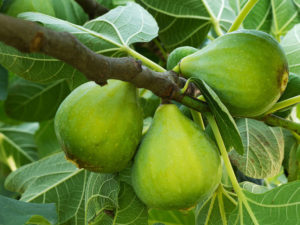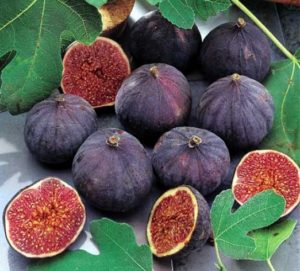General information:-
It is popularly known as “Anjeer” and belongs to family Moraceae. Hot and long summers are good for the cultivation of fig. They can also be grown in containers. The fruits of fig are eaten raw, can be preserved and can be used for cooking purposes. It is considered as the minor fruit crop in India. Maharashtra, Uttar Pradesh, Gujarat, Karnataka, and Tamil Nadu are the major fig farming states. It also has health benefits such as it improves digestion and helps in preventing cancer, heart diseases and hypertension. It is a rich source of antioxidants.
Soil:-
It is grown in variety of soil. Loamy soil having well drainage system is best for fig farming. pH having soil range of 7-8 is optimum for its cultivation.

Popular varieties with yield:-
Brown Turkey: It is medium to large in size, delicious with deep coloured ribs and a medium sized eye. The fruit skin is purplish brown and lighter at the stem end. The flesh is pinkish brown with excellent flavor. The fruit matures from last week of May to end-June. The average yield is 53 kg per tree.
Land preparation:-
At the time of pit preparation, add 5kg cow dung in nursery pits and then add 20-25 kg of phosphorus and potash manure.
Sowing:-
Time of sowing:
Mid-January to first fortnight of February month is suitable for sowing.
Spacing:
Use spacing of 6 X 6m.
Method of sowing:
Propagation method is used.
Propagation:
Mainly propagation is done through cutting. The cutting should be 30-45cm long with at least 3-4 buds. Cuttings are taken from the previous year plant.
Seed:-
Seed rate:
For planting in per acre land, 150 plants are required.
Fertilizer:-
To obtain good yield, adequate nutrition must be ensured in young as well as mature fig trees. Nutrient requirement vary according to age of plant and soil type. The annual nitrogen dose can be split into two applications-first half is applied two months later, when fruits are developing.
Irrigation:-
Fig trees are easily stressed in hot dry periods because of their shallow root system. An even moisture supply during ripening period will cause fruits to split.
Pruning and training:-
Fig trees are trained according to modified leader system. The training is completed in 3-4 years from planting. Fig generally bears fruit individually in the axil of leaves during current season’s growth. Alight winter pruning may help to stimulate new wood growth and increase crop. Mature trees may need a heavy winter pruning approximately after every three years to encourage enough new wood for a good crop. Branches that are diseased, broken or overlapping need to be removed. Bordeaux paste should be used to protect cut ends.

Plant protection:-
Pests and their control:
Leaf defoliators: Defoliators feed themselves on the leaves of the trees.
Control: Spraying of Quinalphos@400ml in 150ltr water per acre should be done to control defoliators.
Stem borers: The borers start reproducing on fig trees by attacking the main stem of the tree.
Control: Application of Phorate granules with kerosene or petrol is done to get rid of stem borers.
Fig flies: It infects the fruit which is not fallen off of the tree.
Control: Application of Triazophos@300ml in 150 ltr water per acre is done to control fig flies.
Disease and their control:-
Rust: If not controlled timely can reduce yield severely. Small brown spots are observed on leaves with black or brown color at centre.
Control: Spraying of Dithane Z-78@400gm or Dithane M-45@400gm in 150 ltr water per acre is done to control the rusts.
Harvesting:-
Commercially harvesting is done from the 3rd year. Mainly harvesting is done in February to march month and ends up in May to June month. Harvesting is done manually in 2-3 intervals. The yield increases as the age of the plant increases. From 8th year onwards it gives an average yield of 18kg per tree.
